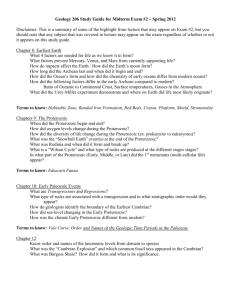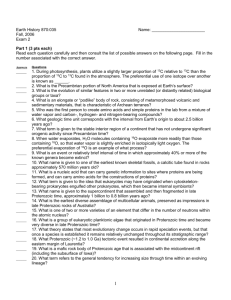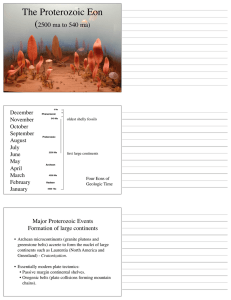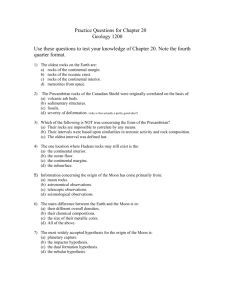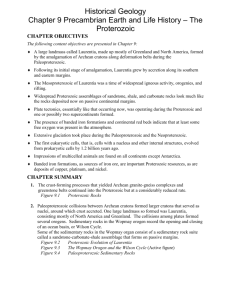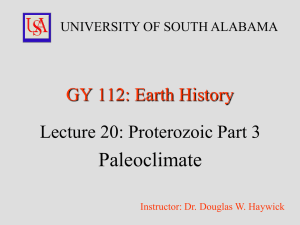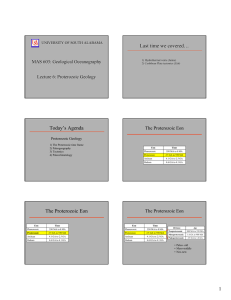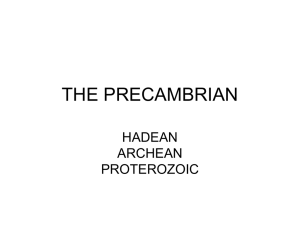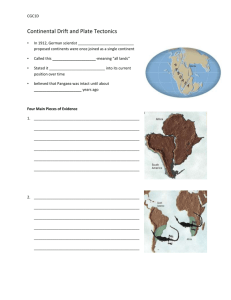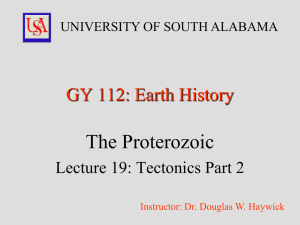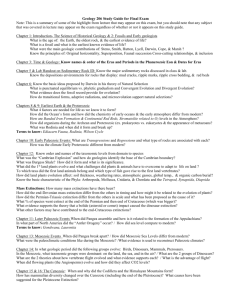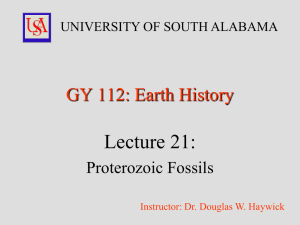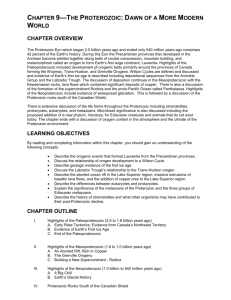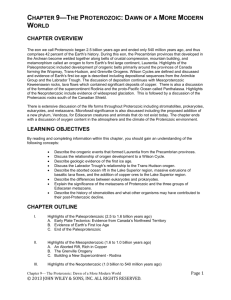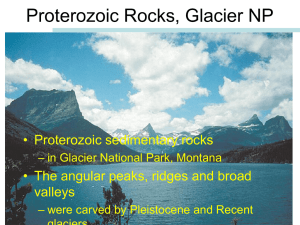Chapter 9: The Proterozoic: Life Becomes a Geologic Force
advertisement
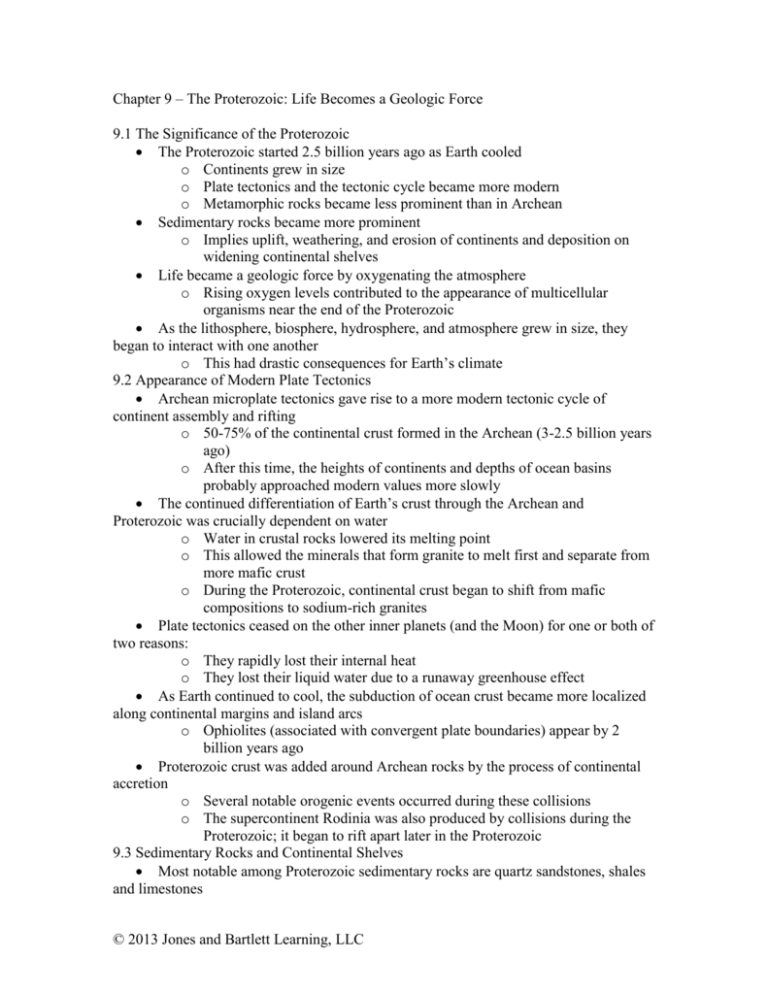
Chapter 9 – The Proterozoic: Life Becomes a Geologic Force 9.1 The Significance of the Proterozoic The Proterozoic started 2.5 billion years ago as Earth cooled o Continents grew in size o Plate tectonics and the tectonic cycle became more modern o Metamorphic rocks became less prominent than in Archean Sedimentary rocks became more prominent o Implies uplift, weathering, and erosion of continents and deposition on widening continental shelves Life became a geologic force by oxygenating the atmosphere o Rising oxygen levels contributed to the appearance of multicellular organisms near the end of the Proterozoic As the lithosphere, biosphere, hydrosphere, and atmosphere grew in size, they began to interact with one another o This had drastic consequences for Earth’s climate 9.2 Appearance of Modern Plate Tectonics Archean microplate tectonics gave rise to a more modern tectonic cycle of continent assembly and rifting o 50-75% of the continental crust formed in the Archean (3-2.5 billion years ago) o After this time, the heights of continents and depths of ocean basins probably approached modern values more slowly The continued differentiation of Earth’s crust through the Archean and Proterozoic was crucially dependent on water o Water in crustal rocks lowered its melting point o This allowed the minerals that form granite to melt first and separate from more mafic crust o During the Proterozoic, continental crust began to shift from mafic compositions to sodium-rich granites Plate tectonics ceased on the other inner planets (and the Moon) for one or both of two reasons: o They rapidly lost their internal heat o They lost their liquid water due to a runaway greenhouse effect As Earth continued to cool, the subduction of ocean crust became more localized along continental margins and island arcs o Ophiolites (associated with convergent plate boundaries) appear by 2 billion years ago Proterozoic crust was added around Archean rocks by the process of continental accretion o Several notable orogenic events occurred during these collisions o The supercontinent Rodinia was also produced by collisions during the Proterozoic; it began to rift apart later in the Proterozoic 9.3 Sedimentary Rocks and Continental Shelves Most notable among Proterozoic sedimentary rocks are quartz sandstones, shales and limestones © 2013 Jones and Bartlett Learning, LLC o The quartz sandstones were produced by chemical weathering of granitic crust; they were deposited in high-energy, nearshore environments, and are texturally and compositionally mature o The limestones contain structures called stromatolites, produced by prokaryotic cyanobacteria o Some Proterozoic limestones may have been precipitated directly from seawater o Proterozoic evaporite deposits also occur; the presence of sulfate minerals indicates rising atmospheric oxygen levels 9.4 Oxygenation of Earth’s Atmosphere Appearance of Oxygen o Free oxygen can be produced by the photolysis of water being degassed from volcanoes o The oxygen combined with iron-rich minerals to form a sedimentary rock called banded iron formation (BIF); these appeared in the Archean and became prominent in the Proterozoic o BIFs consist of alternating layers of iron (present as the mineral hematite) and chert (the jasper variety); their laminations suggest seasonal cycles of sedimentation o The great amount of oxygen required to form the BIFs suggests that photosynthesis was occurring (probably by cyanobacteria in the sunlit waters of the continental shelves) Stages in the Oxygenation of Earth’s Atmosphere o BIFs became prominent around 2.5 billion years ago o Terrestrial redbeds (red sandstones and shales that contain iron oxides) became prominent about 1.5 billion years ago o Uraninite (uranium oxide), which is unstable in an oxygen-rich atmosphere, decreased after 2.3 billion years ago o Paleosols (ancient soils or weathering profiles) younger than 2.2 billion years old retain their iron (indicating increasing oxygen in the atmosphere) Rise of Ozone o Earth’s ozone layer probably began to accumulate after the BIFs stopped accumulating o The ozone layer shields the Earth from ultraviolet radiation, and has made it possible for complex life forms to evolve 9.5 Snowball Earth: Earth out of Balance? Previous Hypotheses for Snowball Earths o During the Neoproterozoic (1.3 billion years-540 million years ago), runaway glaciations covered most or all of Earth (including the topics); each event lasted millions of years o Variations in the sun’s brightness have been suggested as a factor, but in that case runaway glaciations should have occurred throughout the Proterozoic o Fluctuations in the global carbon cycle have also been proposed as a mechanism for the events, but cannot account for the prolonged glaciations or their apparently abrupt termination © 2013 Jones and Bartlett Learning, LLC o Another hypotheses argue that Earth’s axial tilt increased to more than 54 degrees, greatly altering Earth’s climate zonation; however, this model fails to account for the multiple glaciations of Snowball Earth o Other proposals include true polar wander as a factor, or the glacial deposits actually being formed as impact ejects from asteroid impacts. Snowball Earth Reexamined o The most recent Snowball Earth hypothesis incorporates tectonics, climate change, feedback, photosynthesis, and carbon isotopes into cycles lasting about 10 million years each o A milder version of the hypothesis, called Slushball Earth, has also been envisioned How Could Snowball Earths Have Occurred in the First Place? o The lower brightness of the sun during the Neoproterozoic may have made Earth more susceptible to changes in carbon dioxide o Open systems that are just beginning to interact with each other may exhibit nonlinear behavior in which small changes in a system produce a disproportionately large effect; such may have been the case with the Neoproterozoic Earth o Calcareous plankton, a crucial link in the geologic carbon cycle, had not yet evolved during the Precambrian Why Were There No Snowball Venuses? o Several lines of evidence suggest that the tectonic and climatic histories of Earth and Venus began to diverge about 800 million years ago o Plate tectonics seems to have ceased on Venus (although evidence for this remains inconclusive) and it is far too hot for liquid water to exist there Why Didn’t Snowball Earth Recur After the Precambrian? o The sun’s increasing brightness, continued plate tectonic activity, drift of continents toward polar regions, and the biogeochemical cycles of carbon and other elements acted in such a way that Snowball events did not occur after the Precambrian o A further factor is the increasing complexity of the biosphere © 2013 Jones and Bartlett Learning, LLC
